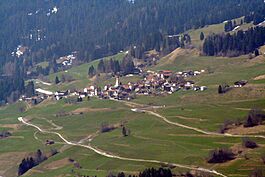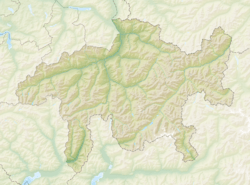Sarn, Switzerland facts for kids
Quick facts for kids
Sarn
|
||
|---|---|---|

Sarn from the air
|
||
|
||
| Country | Switzerland | |
| Canton | Graubünden | |
| District | Hinterrhein | |
| Area | ||
| • Total | 7.6 km2 (2.9 sq mi) | |
| Elevation | 625 m (2,051 ft) | |
| Population | ||
| • Total | 142 | |
| • Density | 18.68/km2 (48.4/sq mi) | |
| Postal code |
7423
|
|
| Surrounded by | Portein, Präz, Safien, Tartar | |
Sarn was a municipality in the district of Hinterrhein in the Swiss canton of Graubünden. On 1 January 2010 the municipalities of Portein, Präz, Sarn, and Tartar merged into the municipality of Cazis.
Contents
History
Sarn is first mentioned in 1156 as Sarn.
Geography
Sarn has an area, as of 2006[update], of 7.6 km2 (2.9 sq mi). Of this area, 78.9% is used for agricultural purposes, while 15.1% is forested. Of the rest of the land, 3.2% is settled (buildings or roads) and the remainder (2.8%) is non-productive (rivers, glaciers or mountains).
The municipality is located in the Thusis sub-district, of the Hinterrhein district. It consists of the haufendorf (an irregular, unplanned and quite closely packed village, built around a central square) village of Sarn on the Heinzenberg mountains. The municipalities of Portein, Präz, Sarn, and Tartar merged on 1 January 2010 into the municipality of Cazis.
Demographics
Sarn has a population (as of 2007[update]) of 142, of which 8.5% are foreign nationals. Over the last 10 years the population has decreased at a rate of -15.5%.
As of 2000[update], the gender distribution of the population was 51.4% male and 48.6% female. The age distribution, as of 2000[update], in Sarn is; 27 people or 17.0% of the population are between 0 and 9 years old. 14 people or 8.8% are 10 to 14, and 9 people or 5.7% are 15 to 19. Of the adult population, 8 people or 5.0% of the population are between 20 and 29 years old. 25 people or 15.7% are 30 to 39, 26 people or 16.4% are 40 to 49, and 16 people or 10.1% are 50 to 59. The senior population distribution is 18 people or 11.3% of the population are between 60 and 69 years old, 14 people or 8.8% are 70 to 79, there are 2 people or 1.3% who are 80 to 89.
In the 2007 federal election the most popular party was the SVP which received 51.5% of the vote. The next three most popular parties were the FDP (18.1%), the FDP (18.1%) and the CVP (11.7%).
The entire Swiss population is generally well educated. In Sarn about 71% of the population (between age 25-64) have completed either non-mandatory upper secondary education or additional higher education (either University or a Fachhochschule).
Sarn has an unemployment rate of 0%. As of 2005[update], there were 39 people employed in the primary economic sector and about 12 businesses involved in this sector. 10 people are employed in the secondary sector and there is 1 business in this sector. 7 people are employed in the tertiary sector, with 6 businesses in this sector.
The historical population is given in the following table:
| year | population |
|---|---|
| 1850 | 259 |
| 1900 | 150 |
| 1950 | 168 |
| 2000 | 159 |
Languages
Most of the population (as of 2000[update]) speaks German (97.5%), with Italian being second most common ( 1.9%) and English being third ( 0.6%).
| Languages | Census 1980 | Census 1990 | Census 2000 | |||
|---|---|---|---|---|---|---|
| Number | Percent | Number | Percent | Number | Percent | |
| German | 115 | 89.15% | 144 | 97.30% | 155 | 97.48% |
| Romanish | 11 | 8.53% | 4 | 2.70% | 0 | 0.00% |
| Italian | 3 | 2.33% | 0 | 0.00% | 3 | 1.94% |
| Population | 129 | 100% | 148 | 100% | 159 | 100% |
See also
 In Spanish: Sarn (Suiza) para niños
In Spanish: Sarn (Suiza) para niños




